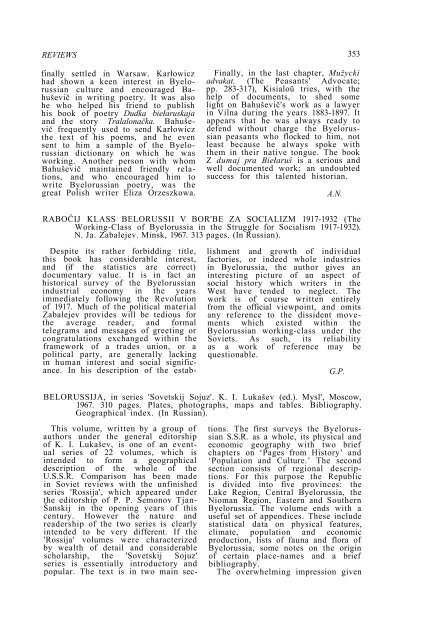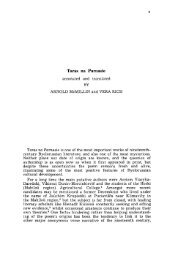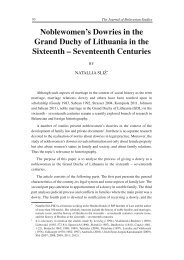Reviews - The Journal of Belarusian Studies
Reviews - The Journal of Belarusian Studies
Reviews - The Journal of Belarusian Studies
You also want an ePaper? Increase the reach of your titles
YUMPU automatically turns print PDFs into web optimized ePapers that Google loves.
REVIEWS 353<br />
finally settled in Warsaw. Karłowicz<br />
had shown a keen interest in Byelorussian<br />
culture and encouraged Bahuševič<br />
in writing poetry. It was also<br />
he who helped his friend to publish<br />
his book <strong>of</strong> poetry Dudka biełaruskaja<br />
and the story Tralalonačka. Bahuševič<br />
frequently used to send Karłowicz<br />
the text <strong>of</strong> his poems, and he even<br />
sent to him a sample <strong>of</strong> the Byelorussian<br />
dictionary on which he was<br />
working. Another person with whom<br />
Bahuševič maintained friendly relations,<br />
and who encouraged him to<br />
write Byelorussian poetry, was the<br />
great Polish writer Eliza Orzeszkowa.<br />
Finally, in the last chapter, Mužycki<br />
advakat. (<strong>The</strong> Peasants' Advocate;<br />
pp. 283-317), Kisialoŭ tries, with the<br />
help <strong>of</strong> documents, to shed some<br />
light on Bahuševič's work as a lawyer<br />
in Vilna during the years 1883-1897. It<br />
appears that he was always ready to<br />
defend without charge the Byelorussian<br />
peasants who flocked to him, not<br />
least because he always spoke with<br />
them in their native tongue. <strong>The</strong> book<br />
Z dumaj pra Biełaruś is a serious and<br />
well documented work; an undoubted<br />
success for this talented historian.<br />
A.N.<br />
RABOČIJ KLASS BELORUSSII V BOR'BE ZA SOCIALIZM 1917-1932 (<strong>The</strong><br />
Working-Class <strong>of</strong> Byelorussia in the Struggle for Socialism 1917-1932).<br />
N. Ja. Zabalejev. Minsk, 1967. 313 pages. (In Russian).<br />
Despite its rather forbidding title,<br />
this book has considerable interest,<br />
and (if the statistics are correct)<br />
documentary value. It is in fact an<br />
historical survey <strong>of</strong> the Byelorussian<br />
industrial economy in the years<br />
immediately following the Revolution<br />
<strong>of</strong> 1917. Much <strong>of</strong> the political material<br />
Zabalejev provides will be tedious for<br />
the average reader, and formal<br />
telegrams and messages <strong>of</strong> greeting or<br />
congratulations exchanged within the<br />
framework <strong>of</strong> a trades union, or a<br />
political party, are generally lacking<br />
in human interest and social significance.<br />
In his description <strong>of</strong> the estab<br />
lishment and growth <strong>of</strong> individual<br />
factories, or indeed whole industries<br />
in Byelorussia, the author gives an<br />
interesting picture <strong>of</strong> an aspect <strong>of</strong><br />
social history which writers in the<br />
West have tended to neglect. <strong>The</strong><br />
work is <strong>of</strong> course written entirely<br />
from the <strong>of</strong>ficial viewpoint, and omits<br />
any reference to the dissident movements<br />
which existed within the<br />
Byelorussian working-class under the<br />
Soviets. As such, its reliability<br />
as a work <strong>of</strong> reference may be<br />
questionable.<br />
G.P.<br />
BELORUSSIJA, in series 'Sovetskij Sojuz'. K. I. Lukašev (ed.). Mysl', Moscow,<br />
1967. 310 pages. Plates, photographs, maps and tables. Bibliography.<br />
Geographical index. (In Russian).<br />
This volume, written by a group <strong>of</strong><br />
authors under the general editorship<br />
<strong>of</strong> K. I. Lukašev, is one <strong>of</strong> an eventual<br />
series <strong>of</strong> 22 volumes, which is<br />
intended to form a geographical<br />
description <strong>of</strong> the whole <strong>of</strong> the<br />
U.S.S.R. Comparison has been made<br />
in Soviet reviews with the unfinished<br />
series 'Rossija', which appeared under<br />
the editorship <strong>of</strong> P. P. Semonov Tjan-<br />
Šanskij in the opening years <strong>of</strong> this<br />
century. However the nature and<br />
readership <strong>of</strong> the two series is clearly<br />
intended to be very different. If the<br />
'Rossija' volumes were characterized<br />
by wealth <strong>of</strong> detail and considerable<br />
scholarship, the 'Sovetskij Sojuz'<br />
series is essentially introductory and<br />
popular. <strong>The</strong> text is in two main sec<br />
tions. <strong>The</strong> first surveys the Byelorussian<br />
S.S.R. as a whole, its physical and<br />
economic geography with two brief<br />
chapters on ‘Pages from History’ and<br />
‘Population and Culture.’ <strong>The</strong> second<br />
section consists <strong>of</strong> regional descriptions.<br />
For this purpose the Republic<br />
is divided into five provinces: the<br />
Lake Region, Central Byelorussia, the<br />
Nioman Region, Eastern and Southern<br />
Byelorussia. <strong>The</strong> volume ends with a<br />
useful set <strong>of</strong> appendices. <strong>The</strong>se include<br />
statistical data on physical features,<br />
climate, population and economic<br />
production, lists <strong>of</strong> fauna and flora <strong>of</strong><br />
Byelorussia, some notes on the origin<br />
<strong>of</strong> certain place-names and a brief<br />
bibliography.<br />
<strong>The</strong> overwhelming impression given





